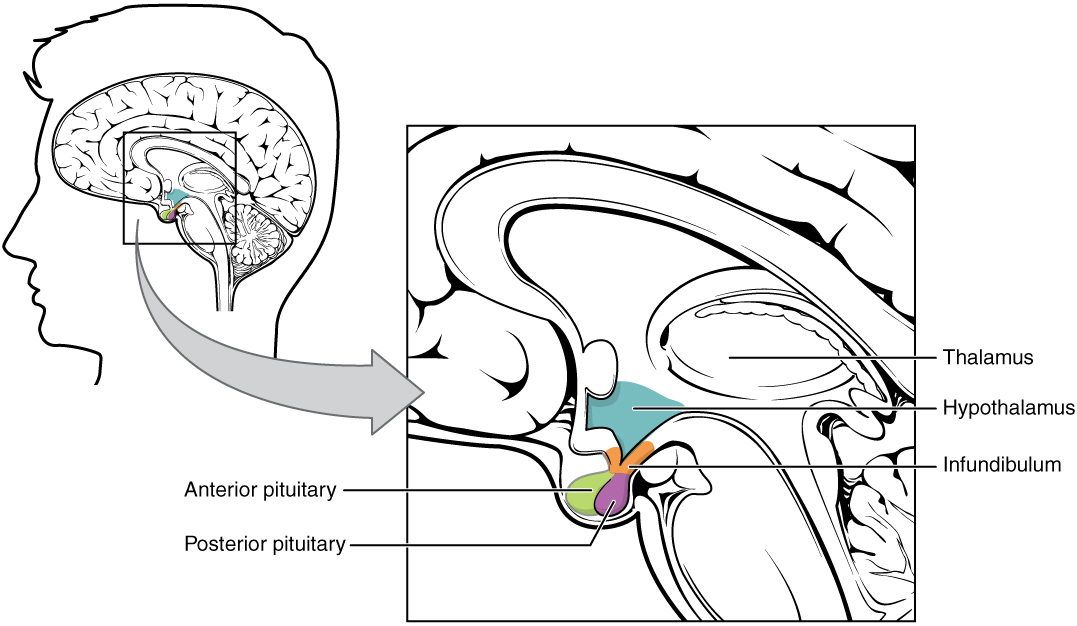Playlist
Show Playlist
Hide Playlist
Antidiuretic Hormone (ADH) and Osmolality
-
Slides 06 BloodandUrineVolume UrinarySystem.pdf
-
Download Lecture Overview
00:01 Here, if we look at this particular graph, we have osmolality on the X-axis and the amount of antidiuretic hormone on the Y. 00:10 Normally, you go through a process in which there’s always some level of antidiuretic hormone that is secreted, and this evolves in a normal plasma osmolality, which is around 300 milliosmoles. 00:25 How does the body normally release this? Again, the hypothalamus is critically involved with the regulation of arginine vasopressin antidiuretic hormone. 00:35 Places such as the paraventricular nucleus and the supraoptic nucleus of the hypothalamus will send a signal to the posterior pituitary and release arginine vasopressin from that locale. 00:51 The process with this in terms of regulation involves both osmoreceptors and baroreceptors. 00:58 So the osmoreceptor are sensing information from what? The change in osmolality. 01:04 Baroreceptors are sending their information about changes in blood pressure. 01:08 Blood pressure is very related to the amount of blood volume that you have. 01:12 So this is both volume and osmolality interrelated. 01:18 The release of arginine vasopressin antidiuretic hormone is done from the posterior pituitary. 01:27 If we look at different volume conditions of the body, you normally look at this kind of linear relationship between osmolality and arginine vasopressin. 01:38 Normally, you’re right about 300 milliosmoles. 01:42 How about what happens if you are dehydrated? So if you’re in a volume expansion condition, that means you have taken in too much water. 01:52 You are hyperhydrated. 01:54 You’ll see that there’s a blunting of the relationship between the increase in osmolality and the increase in our arginine vasopressin. 02:03 If you’re dehydrated, or in a volume contraction state, the opposite is true. 02:08 You now accentuate this relationship. 02:11 So per change in osmolality, you get a greater change in arginine vasopressin release. 02:17 So if you think of that like this, there’s normal linear relationship and you get a volume expansion versus a volume contraction, all altering that relationship between the increase in osmolality to how much arginine vasopressin is released. 02:38 Now, where is that osmolality sensed? These come through with something called circumventricular organs. 02:45 It might have been mentioned before that what circumventricular organs do are the places in the blood-brain barrier that are a little more leaky, allowing you to sense or be able to sample portions of the blood easier. 03:00 These occur right around the ventricles of the brain, so this is the 4th ventricle and especially the 3rd ventricle. 03:08 So circumventricular organs, again, are places in the blood-brain barrier that are leakier. 03:15 This allows for sensing, so there’s sensory circumventricular organs, as well as secretory circumventricular organs. 03:23 The secretory ones allow you to move a substance across the blood-brain barrier in a more easier manner. 03:32 Now, where would you want to secrete something from? Well, maybe the posterior pituitary so you can release arginine vasopressin. 03:40 The sensory circumventricular organs – let’s review those right now. 03:45 We have the subfornical organ, which is known as the SFO, and then the organ vasculosum of the lamina terminalis, which is abbreviated as OVLT. 03:56 These are our primary places in which we’ll sense changes in osmolality. 04:02 If we review the secretory circumventricular organs, we have places like the median eminence and the posterior pituitary. 04:12 Remember, the posterior pituitary is where we release arginine vasopressin or antidiuretic hormone. 04:19 If we put these altogether, you’ll notice that they’re always in a close proximity. 04:24 So the SFO and the OVLT are pretty close to where the hypothalamus is located, and the hypothalamus is located just above the posterior pituitary.
About the Lecture
The lecture Antidiuretic Hormone (ADH) and Osmolality by Thad Wilson, PhD is from the course Urinary Tract Physiology.
Included Quiz Questions
Which of the following is classified as a secretory circumventricular organ?
- Posterior pituitary
- Subfornical organ
- Organum vasculosum of the lamina terminalis (OVLT)
- Anterior pituitary
Which of the following releases AVP/ADH?
- Posterior pituitary
- Paraventricular nucleus
- Third ventricle
- Fourth ventricle
- Median eminence
If a person overconsumes distilled water when their plasma osmolality is 285 mOsm, which of the following alterations in arginine vasopressin (AVP) concentration would most likely occur?
- Decrease
- Increase
- No change
Customer reviews
5,0 of 5 stars
| 5 Stars |
|
1 |
| 4 Stars |
|
0 |
| 3 Stars |
|
0 |
| 2 Stars |
|
0 |
| 1 Star |
|
0 |
Dr. Wilson explains complex concepts clearly and the slides are simple and not cluttered.






